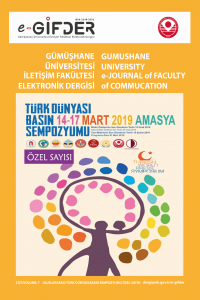Öz
Yeni iletişim teknolojilerinin
21. yüzyılla birlikte toplumsal hayat ve iletişim ortamı üzerinde dönüştürücü
etkileri olmuştur. İnternet ve sosyal medyanın gündelik hayatlara git gide daha
fazla entegre olmasıyla birlikte iletişim ve habercilik anlayışlarında da
değişimler yaşanmıştır. İnternet’in sağladığı, bilgiye kolay ulaşım, haberlerin hızlı
şekilde dolaşımı ve insanları ağlar üzerinde buluşturma gibi faydalarla
birlikte; özellikle sosyal medya üzerinden dolaşıma giren “sahte
haberlerin” kamuoyunun objektif/doğru haberler aracılığıyla oluşması idealini
olumsuz şekilde etkilemektedir. Dijital ortamda faaliyet gösteren
haber doğrulama platformları bu sahte haberlerle mücadelede önemli
rol oynamaya başlamıştır. Bu çerçevede çalışmada, Türkiye ve dünyadan iki haber doğrulama
platformu "Teyit.org” ve "Snopes.com" örnek
vaka olarak seçilmiştir. Öncelikle bu platformların özellikleri
ortaya koyulmuş, kullandıkları haber doğrulama yöntemleri incelenmiş ve içerik
analiziyle bu platformların haber doğrulama süreçlerinde hangi konulara öncelik
verdikleri belirlenmiştir. Ayrıca araştırmada, haber doğrulama amacıyla kurulan
sivil toplum girişimlerinin sınırlılıkları tartışmaya açılmış ve bunların tek
başına yeterli olmayacağı, bireylerin bilinçlenmesi
ve dijital medya okuryazarlığı seviyelerinin arttırılmasının da aynı derecede önemli
olduğunun altı çizilmiştir.
Anahtar Kelimeler
yeni medya sosyal medya haber doğrulama platformları medya okuryazarlığı
Kaynakça
- ALLCOTT, Hunt; GENTZKOW, Matthew (2017) “Social media and fake news in the 2016 election” Journal of Economic Perspectives, Sayı: 31(2), s. 211-36.
- BASTOS, Marco T.; MERCEA, Dan (2017) “The Brexit botnet and user-generated hyperpartisan news” Social Science Computer Review, Sayı: 37(1), s. 38-54.
- BENNETT, W. Lance; ve LIVINGSTON, Steven (2018) “The disinformation order: Disruptive communication and the decline of democratic institutions”, European Journal of Communication, Sayı: 33(2), s. 122-139.
- EDELMAN. (2019). Edelman Trust Barometer: Global Report. https://www.edelman.com/sites/g/files/aatuss191/files/2019-03/2019_Edelman_Trust_Barometer_Global_Report.pdf?utm_source=website&utm_medium=global_report&utm_campaign=downloads Erişim Tarihi: 01.03.2019
- FERRARA, Emilio (2017) “Disinformation and social bot operations in the run up to the 2017 French presidential election”, First Monday, Sayı: 22(8), s. 1-33.
- GAMSON, William A. (2004) “Bystanders, public opinion, and the media”, D.A. Snow, S.A. Soule, H. Kriesi (Ed.) The Blackwell companion to social movements, (ss. 242-261). UK: Blackwell Publishing.
- KAVAKLI, Nurhan (2019) “Üniversite Öğrencileri Arasında İnternet Teyit/Doğrulama Platformlarının Kullanımı” Elektronik Sosyal Bilimler Dergisi, Sayı: 18(69), s. 398-411.
- MARWICK, Alice ve LEWIS, Rebecca (2017) Media manipulation and disinformation online. New York: Data & Society Research Institute.
- MCCOMBS, Maxwell (2018) Setting the agenda: Mass media and public opinion. UK: John Wiley & Sons.
- MCINTYRE, Lee (2018). Post-truth. MIT Press.
- NEWMAN Nick; FLETCHER Richard; KALOGEROPOULOS Antonis, NIELSEN Rasmus Kleis (2019) Reuters Institute Digital News Report. Reuters Institute for the Study of Journalism. https://reutersinstitute.politics.ox.ac.uk/sites/default/files/2019-06/DNR_2019_FINAL_0.pdf Erişim Tarihi 16.06.2019
- SNOPES.COM. (2019) https://snopes.com Erişim Tarihi: 01.03.2019
- SONDERMAN, Jeff (2012) “Most Journalists Now Get Story Ideas from Social Media Sources, Survey Says,” Poynter, Erişim Tarihi: 01.03.2019 http://www.poynter.org/2012/most-journalists-now-get-story-ideas-from-social-media-sources-survey-says/178070/.
- TEYIT.ORG. (2019) https://teyit.org/metodoloji-ve-ilkeler/ Erişim Tarihi: 01.03.2019
- TWITTER (2019) https://twitter.com/teyitorg/status/1090583465291120641 Erişim Tarihi: 01.03.2019
Öz
The new communication technologies have had a
transformative impact on the society and communication
environment in the 21st century. With the integration of the Internet and
social media into everyday life, the practices of communication and journalism have also changed. Although the Internet brought easy access to information, rapid
circulation of news and the network structure which brings people together
easily; circulation of fake news via social media networks emerged as a problem
which endangers the democratic public opinion formation process. Fact-checking
platforms, which operate in digital media, have started to play an important
role concerning the fight against this fake news issue. In this framework, the
two fact-checking websites, “Teyit.org" ve "Snopes.com" have been chosen as case studies. First of all, the features
of these platforms have been put forward, the fact-checking methods they use
have been examined and via content analysis, which issues they prioritize in
fact-checking processes has been revealed. In
addition to that, the limitations of fact-checking services were discussed
in the study. Also, it has been underlined that individual awareness against
fake news and raising digital media literacy levels are equally important in addressing
this issue.
Anahtar Kelimeler
New media Social media Fact-checking platforms Media literacy
Kaynakça
- ALLCOTT, Hunt; GENTZKOW, Matthew (2017) “Social media and fake news in the 2016 election” Journal of Economic Perspectives, Sayı: 31(2), s. 211-36.
- BASTOS, Marco T.; MERCEA, Dan (2017) “The Brexit botnet and user-generated hyperpartisan news” Social Science Computer Review, Sayı: 37(1), s. 38-54.
- BENNETT, W. Lance; ve LIVINGSTON, Steven (2018) “The disinformation order: Disruptive communication and the decline of democratic institutions”, European Journal of Communication, Sayı: 33(2), s. 122-139.
- EDELMAN. (2019). Edelman Trust Barometer: Global Report. https://www.edelman.com/sites/g/files/aatuss191/files/2019-03/2019_Edelman_Trust_Barometer_Global_Report.pdf?utm_source=website&utm_medium=global_report&utm_campaign=downloads Erişim Tarihi: 01.03.2019
- FERRARA, Emilio (2017) “Disinformation and social bot operations in the run up to the 2017 French presidential election”, First Monday, Sayı: 22(8), s. 1-33.
- GAMSON, William A. (2004) “Bystanders, public opinion, and the media”, D.A. Snow, S.A. Soule, H. Kriesi (Ed.) The Blackwell companion to social movements, (ss. 242-261). UK: Blackwell Publishing.
- KAVAKLI, Nurhan (2019) “Üniversite Öğrencileri Arasında İnternet Teyit/Doğrulama Platformlarının Kullanımı” Elektronik Sosyal Bilimler Dergisi, Sayı: 18(69), s. 398-411.
- MARWICK, Alice ve LEWIS, Rebecca (2017) Media manipulation and disinformation online. New York: Data & Society Research Institute.
- MCCOMBS, Maxwell (2018) Setting the agenda: Mass media and public opinion. UK: John Wiley & Sons.
- MCINTYRE, Lee (2018). Post-truth. MIT Press.
- NEWMAN Nick; FLETCHER Richard; KALOGEROPOULOS Antonis, NIELSEN Rasmus Kleis (2019) Reuters Institute Digital News Report. Reuters Institute for the Study of Journalism. https://reutersinstitute.politics.ox.ac.uk/sites/default/files/2019-06/DNR_2019_FINAL_0.pdf Erişim Tarihi 16.06.2019
- SNOPES.COM. (2019) https://snopes.com Erişim Tarihi: 01.03.2019
- SONDERMAN, Jeff (2012) “Most Journalists Now Get Story Ideas from Social Media Sources, Survey Says,” Poynter, Erişim Tarihi: 01.03.2019 http://www.poynter.org/2012/most-journalists-now-get-story-ideas-from-social-media-sources-survey-says/178070/.
- TEYIT.ORG. (2019) https://teyit.org/metodoloji-ve-ilkeler/ Erişim Tarihi: 01.03.2019
- TWITTER (2019) https://twitter.com/teyitorg/status/1090583465291120641 Erişim Tarihi: 01.03.2019
Ayrıntılar
| Birincil Dil | Türkçe |
|---|---|
| Bölüm | Araştırma Makalesi |
| Yazarlar | |
| Yayımlanma Tarihi | 26 Aralık 2019 |
| Gönderilme Tarihi | 28 Haziran 2019 |
| Yayımlandığı Sayı | Yıl 2019 Cilt: 7 Sayı: 3 |

